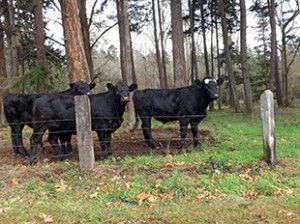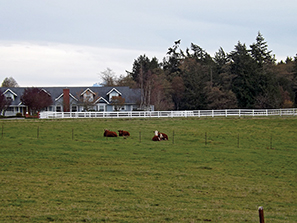 Cattle and other livestock with access to streams, lakes, or wetlands deposit manure into the water or onto nearby land, which runs off into the streams and lakes during rain events. Manure can contaminate waterways with bacteria, viruses, parasites, and other pathogens. Livestock that congregate near streams often strip stream banks of vegetation causing stream bank instability and erosion. Stream channels start to widen because there’s nothing to hold the bank in place. Livestock like to be near streams because it’s less distance for a drink of water and it’s often cooler. Thus they tend to overgraze near streams, turning the area into a mud pit during the winter, increasing erosion and providing little in the way of feed.
Cattle and other livestock with access to streams, lakes, or wetlands deposit manure into the water or onto nearby land, which runs off into the streams and lakes during rain events. Manure can contaminate waterways with bacteria, viruses, parasites, and other pathogens. Livestock that congregate near streams often strip stream banks of vegetation causing stream bank instability and erosion. Stream channels start to widen because there’s nothing to hold the bank in place. Livestock like to be near streams because it’s less distance for a drink of water and it’s often cooler. Thus they tend to overgraze near streams, turning the area into a mud pit during the winter, increasing erosion and providing little in the way of feed.
 The responsible management practice is to fence animals away from streams and waterbodies, providing an adequate riparian buffer zone to protect water quality. Fences can range from multi-strand, high-tensile fences that can be electrified to more robust woven wire fencing. For interior paddock fences, animals accustomed to electric fences can often be controlled by a single strand of wire. When placing fencing consider the animal species, the number of animals, vegetation density, and slope. Another benefit of keeping livestock out of streams is that it reduces the risk of disease from hoof-rot and waterborne bacteria, and provides firm footing to reduce the chance of leg injury. Fencing strategies that include rotating livestock from pasture to pasture, preventing overgrazing and allowing for quicker regrowth of moderately grazed areas can also create more productive pastures.
The responsible management practice is to fence animals away from streams and waterbodies, providing an adequate riparian buffer zone to protect water quality. Fences can range from multi-strand, high-tensile fences that can be electrified to more robust woven wire fencing. For interior paddock fences, animals accustomed to electric fences can often be controlled by a single strand of wire. When placing fencing consider the animal species, the number of animals, vegetation density, and slope. Another benefit of keeping livestock out of streams is that it reduces the risk of disease from hoof-rot and waterborne bacteria, and provides firm footing to reduce the chance of leg injury. Fencing strategies that include rotating livestock from pasture to pasture, preventing overgrazing and allowing for quicker regrowth of moderately grazed areas can also create more productive pastures.
Providing an alternative source of water, as well as providing shade, salt, and supplemental feed in a location away from a stream or lake, will help keep livestock out of the water. Watering troughs that mechanically or electrically pump water from the stream or lake are available. They provide water for the livestock while protecting stream or lake banks and keeping manure a safe distance from the waterbody. Check with your conservation district about the options. Stream crossings are sometimes required to provide livestock access to pastures on the other side of the stream. A stable, firm crossing will reduce access to the stream and provide solid footing for the livestock. Grazing near riparian areas should be very limited during the dormant fall and winter seasons.
Refer to Guideline 1 for how to manage livestock waste.